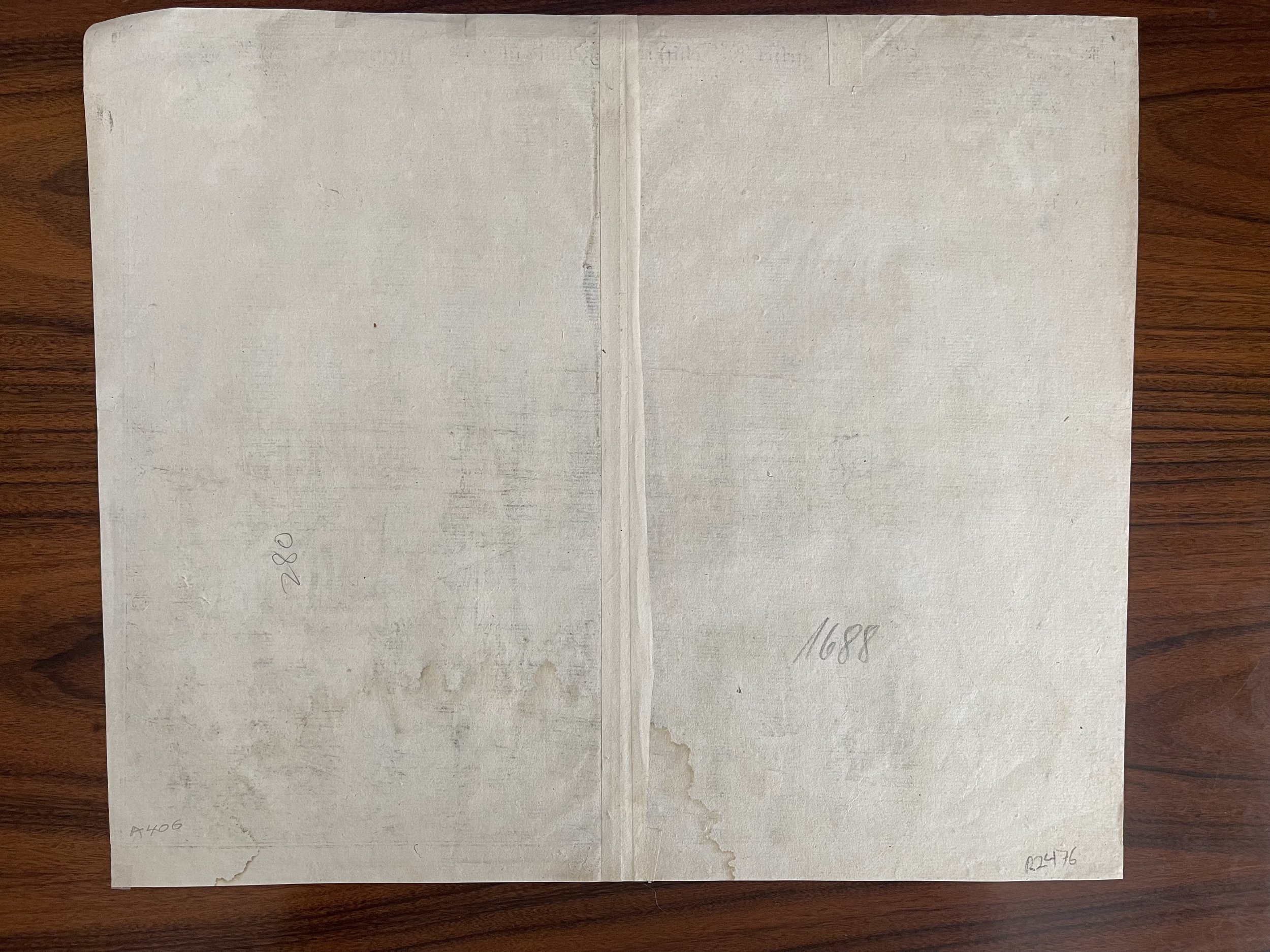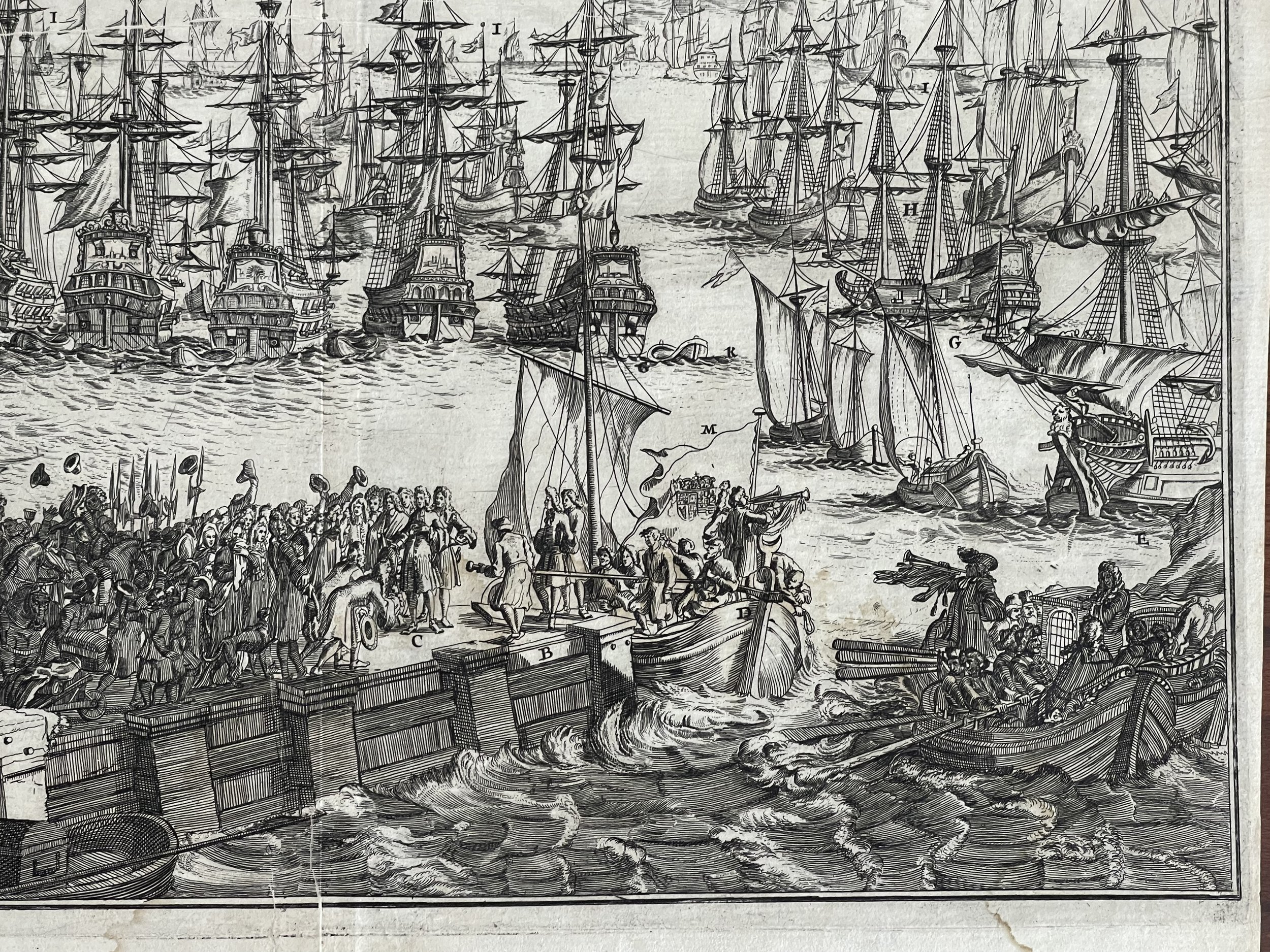Departure of Wilhelm III of Orange with his fleet, leaving to conquer England - Matthaus Merian - Frankfurt 1698
Departure from Holland and the arrival in London of William III, Prince of Orange - Matthaus Merian - 1698
S. K. H. gehet zu Schiff in Engelland über Zufahren
Unusual print showing the departure of Wilhelm III of Oranien with his fleet, leaving to conquer England in November 1688.
Very detailed view showing many ships in detail, Wilhelm further with people loading goods on the pier. With a legend explaining 13 points (A-M).
Rare engraving - seldom offered on the market!
His engravings illustrate the celebrations on the departure from Holland and the arrival in London of William III, Prince of Orange, during the Glorious Revolution in 1688. S.K.H Gehet zu Schiff in Engelland... illustrates the departure with a large fleet assembled in the Meuse. In the foreground a crowd of people are gathered on the jetty at Hellevoetsluis, where Prince William is about to embark on the small boat that will take him to his flagship. The depiction of the crowd contains closely detailed observations, such as a coach driver with a whip, people struggling through the crowd with their luggage, and couples saying their farewells. Einzug Wilhelmi Henrici Prinzen von Orange… illustrates the arrival amid fanfare and celebration.
Matthäus Merian der Ältere (or "Matthew", "the Elder", or "Sr."; 22 September 1593 – 19 June 1650) was a Swiss-born engraver who worked in Frankfurt, Germany for most of his career, where he also ran a publishing house. He was a member of the patrician Basel Merian family.
Born in Basel, Merian learned the art of copperplate engraving in Zürich. He next worked and studied in Strasbourg, Nancy, and Paris, before returning to Basel in 1615. The following year he moved to Oppenheim, Germany where he worked for the publisher Johann Theodor de Bry, who was the son of renowned engraver and traveller Theodor de Bry.
In 1623 Merian took over the publishing house of his father-in-law after de Bry's death. In 1626 he became a citizen of Frankfurt and could henceforth work as an independent publisher. He spent most of his working life in Frankfurt.
Early in his life, he had created detailed town plans in his unique style, e.g. a plan of Basel (1615) and a plan of Paris (1615). With Martin Zeiler (1589–1661), a German geographer, and later (c. 1640) with his own son, Matthäus Merian (der Jüngere, i.e. "the Younger" or "Jr.") (1621–1687), he produced a series of Topographia. The 21-volume set was collectively known as the Topographia Germaniae. It includes numerous town plans and views, as well as maps of most countries and a World Map—it was such a popular work that it was re-issued in many editions. He also took over and completed the later parts and editions of the Grand Voyages and Petits Voyages, originally started by de Bry in 1590 and included volumes India Orientalis and America Occidentalis.
Merian's work inspired the Suecia Antiqua et Hodierna by Erik Dahlberg. The German travel magazine Merian is named after him.
He was also noted for the finesse of his alchemical illustrations, in books such as the Musaeum Hermeticum (1678) and Atalanta Fugiens (1618). He undertook the engravings for the encyclopaedic work of insect natural history De Serpentibus, compiled by John Jonston. This tradition would be taken up by his daughter.
Matthäus Merian died after several years of illness in 1650 in Langenschwalbach, near Wiesbaden.
After his death, his sons Matthäus Jr. and Caspar took over the publishing house. They continued publishing the Topographia Germaniae and the Theatrum Europaeum under the name Merian Erben (i.e. Merian Heirs).
Departure from Holland and the arrival in London of William III, Prince of Orange - Matthaus Merian - 1698
S. K. H. gehet zu Schiff in Engelland über Zufahren
Unusual print showing the departure of Wilhelm III of Oranien with his fleet, leaving to conquer England in November 1688.
Very detailed view showing many ships in detail, Wilhelm further with people loading goods on the pier. With a legend explaining 13 points (A-M).
Rare engraving - seldom offered on the market!
His engravings illustrate the celebrations on the departure from Holland and the arrival in London of William III, Prince of Orange, during the Glorious Revolution in 1688. S.K.H Gehet zu Schiff in Engelland... illustrates the departure with a large fleet assembled in the Meuse. In the foreground a crowd of people are gathered on the jetty at Hellevoetsluis, where Prince William is about to embark on the small boat that will take him to his flagship. The depiction of the crowd contains closely detailed observations, such as a coach driver with a whip, people struggling through the crowd with their luggage, and couples saying their farewells. Einzug Wilhelmi Henrici Prinzen von Orange… illustrates the arrival amid fanfare and celebration.
Matthäus Merian der Ältere (or "Matthew", "the Elder", or "Sr."; 22 September 1593 – 19 June 1650) was a Swiss-born engraver who worked in Frankfurt, Germany for most of his career, where he also ran a publishing house. He was a member of the patrician Basel Merian family.
Born in Basel, Merian learned the art of copperplate engraving in Zürich. He next worked and studied in Strasbourg, Nancy, and Paris, before returning to Basel in 1615. The following year he moved to Oppenheim, Germany where he worked for the publisher Johann Theodor de Bry, who was the son of renowned engraver and traveller Theodor de Bry.
In 1623 Merian took over the publishing house of his father-in-law after de Bry's death. In 1626 he became a citizen of Frankfurt and could henceforth work as an independent publisher. He spent most of his working life in Frankfurt.
Early in his life, he had created detailed town plans in his unique style, e.g. a plan of Basel (1615) and a plan of Paris (1615). With Martin Zeiler (1589–1661), a German geographer, and later (c. 1640) with his own son, Matthäus Merian (der Jüngere, i.e. "the Younger" or "Jr.") (1621–1687), he produced a series of Topographia. The 21-volume set was collectively known as the Topographia Germaniae. It includes numerous town plans and views, as well as maps of most countries and a World Map—it was such a popular work that it was re-issued in many editions. He also took over and completed the later parts and editions of the Grand Voyages and Petits Voyages, originally started by de Bry in 1590 and included volumes India Orientalis and America Occidentalis.
Merian's work inspired the Suecia Antiqua et Hodierna by Erik Dahlberg. The German travel magazine Merian is named after him.
He was also noted for the finesse of his alchemical illustrations, in books such as the Musaeum Hermeticum (1678) and Atalanta Fugiens (1618). He undertook the engravings for the encyclopaedic work of insect natural history De Serpentibus, compiled by John Jonston. This tradition would be taken up by his daughter.
Matthäus Merian died after several years of illness in 1650 in Langenschwalbach, near Wiesbaden.
After his death, his sons Matthäus Jr. and Caspar took over the publishing house. They continued publishing the Topographia Germaniae and the Theatrum Europaeum under the name Merian Erben (i.e. Merian Heirs).
Departure from Holland and the arrival in London of William III, Prince of Orange - Matthaus Merian - 1698
S. K. H. gehet zu Schiff in Engelland über Zufahren
Unusual print showing the departure of Wilhelm III of Oranien with his fleet, leaving to conquer England in November 1688.
Very detailed view showing many ships in detail, Wilhelm further with people loading goods on the pier. With a legend explaining 13 points (A-M).
Rare engraving - seldom offered on the market!
His engravings illustrate the celebrations on the departure from Holland and the arrival in London of William III, Prince of Orange, during the Glorious Revolution in 1688. S.K.H Gehet zu Schiff in Engelland... illustrates the departure with a large fleet assembled in the Meuse. In the foreground a crowd of people are gathered on the jetty at Hellevoetsluis, where Prince William is about to embark on the small boat that will take him to his flagship. The depiction of the crowd contains closely detailed observations, such as a coach driver with a whip, people struggling through the crowd with their luggage, and couples saying their farewells. Einzug Wilhelmi Henrici Prinzen von Orange… illustrates the arrival amid fanfare and celebration.
Matthäus Merian der Ältere (or "Matthew", "the Elder", or "Sr."; 22 September 1593 – 19 June 1650) was a Swiss-born engraver who worked in Frankfurt, Germany for most of his career, where he also ran a publishing house. He was a member of the patrician Basel Merian family.
Born in Basel, Merian learned the art of copperplate engraving in Zürich. He next worked and studied in Strasbourg, Nancy, and Paris, before returning to Basel in 1615. The following year he moved to Oppenheim, Germany where he worked for the publisher Johann Theodor de Bry, who was the son of renowned engraver and traveller Theodor de Bry.
In 1623 Merian took over the publishing house of his father-in-law after de Bry's death. In 1626 he became a citizen of Frankfurt and could henceforth work as an independent publisher. He spent most of his working life in Frankfurt.
Early in his life, he had created detailed town plans in his unique style, e.g. a plan of Basel (1615) and a plan of Paris (1615). With Martin Zeiler (1589–1661), a German geographer, and later (c. 1640) with his own son, Matthäus Merian (der Jüngere, i.e. "the Younger" or "Jr.") (1621–1687), he produced a series of Topographia. The 21-volume set was collectively known as the Topographia Germaniae. It includes numerous town plans and views, as well as maps of most countries and a World Map—it was such a popular work that it was re-issued in many editions. He also took over and completed the later parts and editions of the Grand Voyages and Petits Voyages, originally started by de Bry in 1590 and included volumes India Orientalis and America Occidentalis.
Merian's work inspired the Suecia Antiqua et Hodierna by Erik Dahlberg. The German travel magazine Merian is named after him.
He was also noted for the finesse of his alchemical illustrations, in books such as the Musaeum Hermeticum (1678) and Atalanta Fugiens (1618). He undertook the engravings for the encyclopaedic work of insect natural history De Serpentibus, compiled by John Jonston. This tradition would be taken up by his daughter.
Matthäus Merian died after several years of illness in 1650 in Langenschwalbach, near Wiesbaden.
After his death, his sons Matthäus Jr. and Caspar took over the publishing house. They continued publishing the Topographia Germaniae and the Theatrum Europaeum under the name Merian Erben (i.e. Merian Heirs).
Code : A406
Cartographer : Cartographer / Engraver / Publisher: Matthaus Merian
Date : Publication Place / Date - Circa 1698
Size : Sheet size: Image Size: 38 x 33 cm
Availability : Available
Type - Genuine - Antique
Grading A-
Where Applicable - Folds as issued. Light box photo shows the folio leaf centre margin hinge ‘glue’, this is not visible otherwise.
Tracked postage, in casement. Please contact me for postal quotation outside of the UK.












